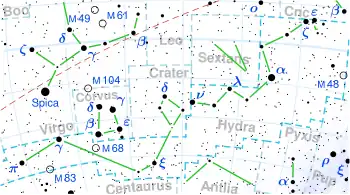 | |
| Observation data Epoch J2000.0 Equinox J2000.0 | |
|---|---|
| Constellation | Hydra |
| Right ascension | 13h 18m 55.29719s[1] |
| Declination | –23° 10′ 17.4514″[1] |
| Apparent magnitude (V) | +2.993[2] |
| Characteristics | |
| Spectral type | G8 III[3] |
| U−B color index | +0.645[2] |
| B−V color index | +0.920[2] |
| Astrometry | |
| Radial velocity (Rv) | –5.4[4] km/s |
| Proper motion (μ) | RA: +68.99[1] mas/yr Dec.: –41.85[1] mas/yr |
| Parallax (π) | 24.37 ± 0.15 mas[1] |
| Distance | 133.8 ± 0.8 ly (41.0 ± 0.3 pc) |
| Absolute magnitude (MV) | –0.15[3] |
| Details | |
| Mass | 2.94[3] M☉ |
| Radius | 16±3[5] R☉ |
| Luminosity | 115[3] L☉ |
| Surface gravity (log g) | 3.02[6] cgs |
| Temperature | 5,087[6] K |
| Metallicity [Fe/H] | –0.06[6] dex |
| Rotational velocity (v sin i) | 8[7] km/s |
| Age | 372[3] Myr |
| Other designations | |
| Database references | |
| SIMBAD | data |
Gamma Hydrae (γ Hya, γ Hydrae) is a star in the equatorial constellation of Hydra. It has an apparent visual magnitude of 3.0,[2] placing it second in brightness among the members of this generally faint constellation. Based upon parallax measurements made during the Hipparcos mission, this star is at a distance of around 133.8 light-years (41.0 parsecs) from Earth.[1]
The stellar spectrum matches a stellar classification of G8 III,[3] with the luminosity class of III indicating it has evolved into a giant star after exhausting the supply of hydrogen at its core. It has nearly three[3] times the mass of the Sun and 16 times the Sun's radius.[5] The star is radiating 115[3] times the Sun's luminosity from its outer atmosphere at an effective temperature of 5,019 K.[3] This heat gives it the yellow glow of a K-type star.[9] Despite having reached an advanced stage in its evolution, it is considerably younger than the Sun with an age of around 372 million years. This is because higher mass stars consume their nuclear fuel at a more rapid rate.[3]
In culture
γ Hya appears on the flag of Brazil, symbolising the state of Acre.[10]
References
- 1 2 3 4 5 6 van Leeuwen, F. (November 2007), "Validation of the new Hipparcos reduction", Astronomy and Astrophysics, 474 (2): 653–664, arXiv:0708.1752, Bibcode:2007A&A...474..653V, doi:10.1051/0004-6361:20078357, S2CID 18759600
- 1 2 3 4 Gutierrez-Moreno, Adelina; et al. (1966), "A System of photometric standards", Publications of the Department of Astronomy University of Chile, Publicaciones Universidad de Chile, Department de Astronomy, 1: 1–17, Bibcode:1966PDAUC...1....1G
- 1 2 3 4 5 6 7 8 9 10 Takeda, Yoichi; Sato, Bun'ei; Murata, Daisuke (August 2008), "Stellar Parameters and Elemental Abundances of Late-G Giants", Publications of the Astronomical Society of Japan, 60 (4): 781–802, arXiv:0805.2434, Bibcode:2008PASJ...60..781T, doi:10.1093/pasj/60.4.781
- ↑ Wielen, R.; et al. (1999), "Sixth Catalogue of Fundamental Stars (FK6). Part I. Basic fundamental stars with direct solutions", Veroeffentlichungen des Astronomischen Rechen-Instituts Heidelberg, Astronomisches Rechen-Institut Heidelberg, 35 (35): 1, Bibcode:1999VeARI..35....1W
- 1 2 Arroyo-Torres, B.; et al. (June 2014), "VLTI/AMBER observations of cold giant stars: atmospheric structures and fundamental parameters", Astronomy & Astrophysics, 566: 11, arXiv:1404.7384, Bibcode:2014A&A...566A..88A, doi:10.1051/0004-6361/201323264, S2CID 16778588, A88.
- 1 2 3 Cenarro, A. J.; et al. (January 2007), "Medium-resolution Isaac Newton Telescope library of empirical spectra - II. The stellar atmospheric parameters", Monthly Notices of the Royal Astronomical Society, 374 (2): 664–690, arXiv:astro-ph/0611618, Bibcode:2007MNRAS.374..664C, doi:10.1111/j.1365-2966.2006.11196.x, S2CID 119428437
- ↑ Bernacca, P. L.; Perinotto, M. (1970), "A catalogue of stellar rotational velocities", Contributi Osservatorio Astronomico di Padova in Asiago, 239 (1): 1, Bibcode:1970CoAsi.239....1B
- ↑ "gam Hya". SIMBAD. Centre de données astronomiques de Strasbourg. Retrieved 2012-02-23.
- ↑ "The Colour of Stars", Australia Telescope, Outreach and Education, Commonwealth Scientific and Industrial Research Organisation, December 21, 2004, archived from the original on 2012-03-18, retrieved 2012-01-16
- ↑ Astronomy of the Brazilian Flag, FOTW Flags Of The World website